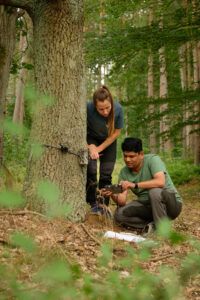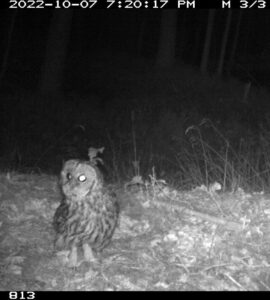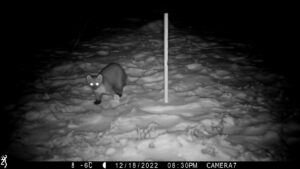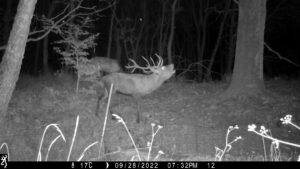Nature and wildlife are the subject of many interests, from the state nature conservation and forestry administration to landowners and land users such as farmers and hunters, to conservation organisations and local people who love and want to preserve their environs. To find a consensus between the different concerns and to protect landscapes and wildlife together, cooperation between all stakeholders is crucial.
A new large-scope study
Since 2012, conservationists organised in Rewilding Oder Delta (ROD), a regional conservation organisation in north-eastern Mecklenburg-Vorpommern and north-western Poland, have been working together with scientists, authorities, and land users to support sustainable regional development in the Oder Delta, revitalise the semi-natural landscapes and develop a common vision for the transboundary area around the Szczecin Lagoon.

This successful cooperation gained momentum in 2020 when the German Federal Ministry of Education and Research (BMBF) began funding the transdisciplinary project REWILD_DE – one of 19 innovative projects selected nationwide on the topic of “Valuing and safeguarding biodiversity in politics, business and society” (BiodiWert) as part of the BMBF’s Research Initiative for Biodiversity Conservation (FEdA). The 3-year large-scale project is coordinated by the Helmholtz Centre for Environmental Research (UFZ) and implemented in cooperation with the German Centre for Integrative Biodiversity Research (iDiv), the Martin Luther University Halle-Wittenberg (MLU), the University for Sustainable Development Eberswalde (HNEE) and the practice partner ROD.
Thanks to the funding, it was possible, among other things, to initiate comprehensive wildlife monitoring with so-called camera traps in the region. “These simple, non-intrusive devices are set up at selected locations and automatically triggered by movement and body heat of the animals in their vicinity.”, explains Sandeep Sharma, researcher at iDiv. “They record the presence and activity of species 24/7, thus giving us a good overview of species abundance and composition in the area”. In Fall 2022, ROD conservationists and scientists from the German Centre for Integrative Biodiversity Research (iDiv) set up 60 such camera traps in the region with the consent and support of local authorities, landowners and land users.
First results and surprises

The ecologists had indeed expected the recorded abundance of wildlife at many sites: The diversity of species, ranging from herbivores such as hare, roe deer, red deer and fallow deer to small, medium and large carnivores such as otter, pine marten, fox and wolf to bird species such as the European crane, proves the high ecological value of the region. The cameras also recorded the presence and distribution of invasive species such as raccoon and raccoon dog. Beyond that, however, the researchers experienced a big surprise just a few months into the project. “One of our camera traps recorded an owl that many expert ornithologists thought was a Ural owl,” says Ulrich Stöcker, managing director of Rewilding Oder Delta. “This bird species has only been observed in Germany sporadically in Saxony in recent years with a small population in Bavaria thanks to a reintroduction project, so the find would be extremely unusual across Germany.” The rare owl needs a mixture of mature forests (>60 years) with tree hollows for nesting and open areas for hunting, which are becoming increasingly scarce in Germany. “With very few undisturbed old-growth forests left in Germany, our observations underpin further efforts to restore these important ecosystems where rare and, as we can see, even regionally extinct wildlife can thrive again,” adds Stöcker.
Could it be a regionally extinct species?

Due to the rarity of the bird species in Germany, the research team first contacted zoos and bird enclosures to see if there were any escapees from captivity: no such case found. “At present, our observation is not yet considered officially confirmed and in order to provide an additional data basis, we plan to install acoustic monitoring devices in the vicinity of the observation site.”, says Wiebke Brenner, wildlife biologist at the ROD. “An occurrence of this extremely rare bird in the Odra delta would indeed be spectacular, but for us this just shows how important it is to work together and systematically record wildlife. I am sure we will make many more surprising discoveries in our project in the coming years.”
Benefits of collaboration

One of the challenges in the project was to get the support of the local private forest owners and hunters on whose lands the camera traps would be set up. However, the team also met many supporters of the project. “Often forest owners and hunters react with caution when others want to place camera traps in their forests and hunting grounds,” says Dr Heinrich Löhr, a forest owner and hunter in whose forest one of the project camera traps was placed. “But systematic wildlife monitoring is very important, and projects like this allow individual forest owners and users to not only gain valuable information about their own areas, but also to gain a better understanding of wildlife ecology from a regional perspective and beyond incidental observations.”
Further Information:
- REWILD_DE project website: https://www.ufz.de/rewild_de/
- FEdA Website: https://www.feda.bio/